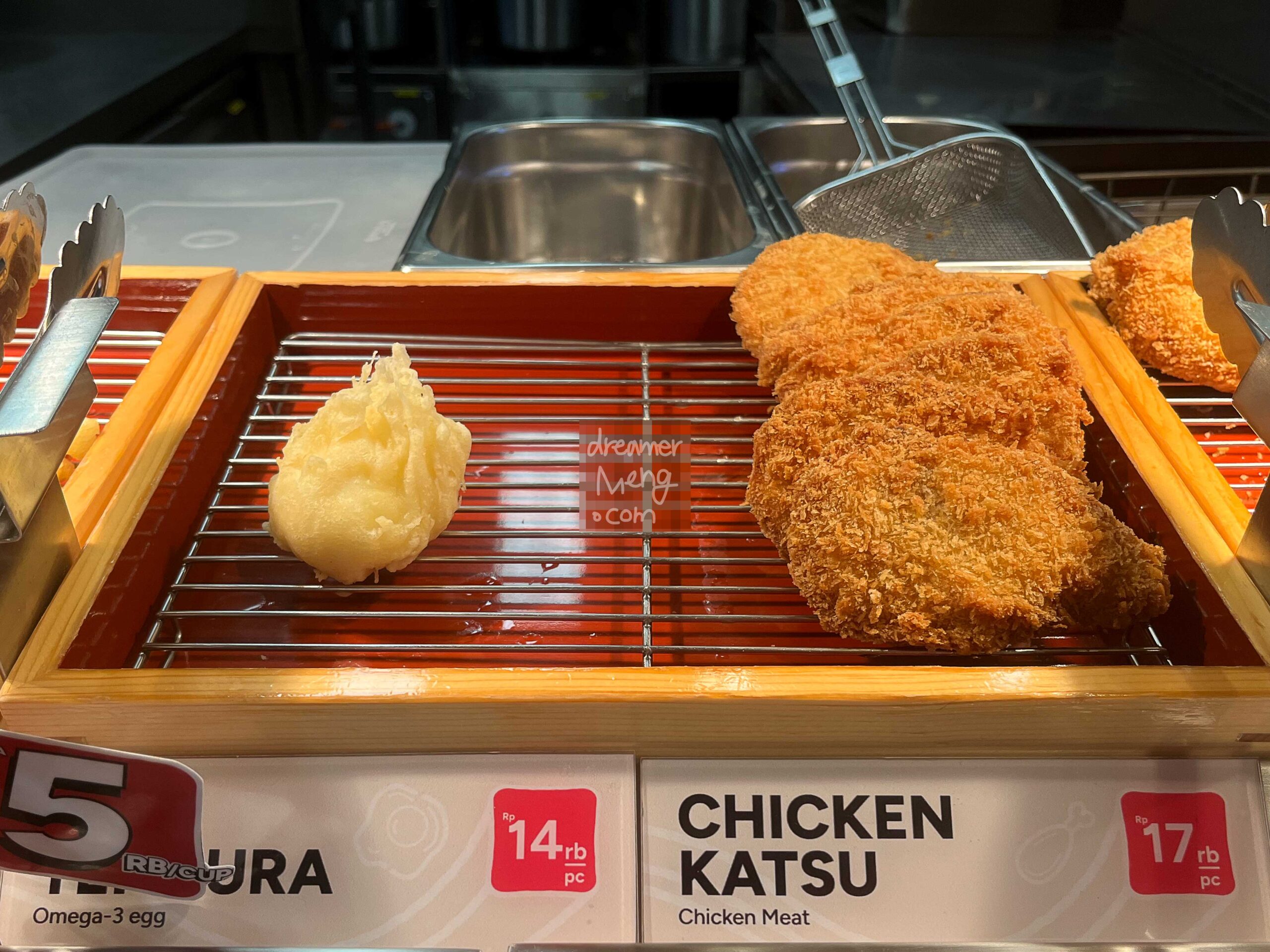Marugame Udon is a udon specialized restaurant based in Takamatsu, Kagawa Prefecture, Japan, and it has branches in several countries, including South Korea, the United States, Taiwan, Hong Kong, Indonesia, and Malaysia.
I still remember when Marugame Udon first opened in the Mal Bali Galeria shopping mall; it was bustling with people eager to enjoy their udon. Of course, I also visited there often with friends to savor a bowl of udon. Now, they operate a total of three locations in Bali, including branches in the Living World shopping mall in Gatot Subroto and Teuku Umar.
Among them, I frequently visit the Marugame Udon Denpasar branch on Jl. Teuku Umar, as it’s the largest and truly captures the unique atmosphere of Marugame.
Marugame is a city in Kagawa Prefecture, Japan, known for its delicious udon, a traditional Japanese noodle dish.
While I didn’t find the traditional family business story I expected, Marugame Udon has quickly expanded since its launch in 2000 and continues to enjoy steady popularity as an udon chain.
Marugame Udon is located at the multi-lane roundabout on Jl. Teuku Umar.
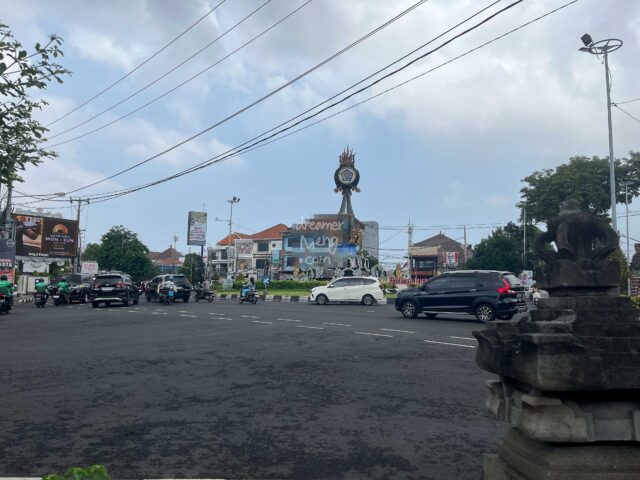
In Indonesian, a roundabout is called a “Bunderan.” While it’s not wrong to refer to this place as Bunderan, the roundabouts in Bali each have their own unique names.
So, it’s more accurate to call this spot Simpang Enam.
The “Enam” in Simpang Enam means ‘6,’ indicating that six roads converge here.
Nearby, you’ll find Akasaka Karaoke, along with several cafes and restaurants, including Fore Coffee and KFC. Fore Coffee seems to be an Indonesian café franchise, and since it’s conveniently located and looks quite popular, I’m definitely planning to check it out next time.
When I entered, the striking building of Marugame Udon immediately stood out.

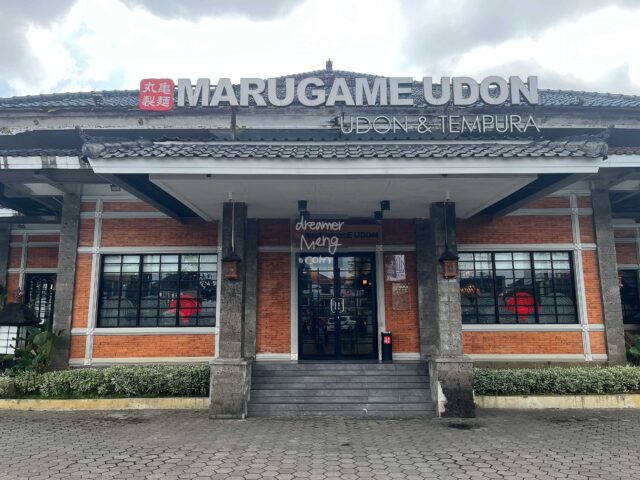
Originally, this structure preserved the traditional Balinese architectural style, but with the arrival of Marugame Udon, some modern elements were introduced. Sleek decorations were added to the windows and exterior walls, giving the restaurant a cleaner and more contemporary look, while the basic facade, roof, and entrance still reflected traditional Balinese design.
The brick exterior beautifully showcased the warm colors and textures typical of Balinese architecture, and the added decorations complemented the elegant design. Notably, the roof maintained its traditional Balinese style, harmonizing with white pillars that enhanced the overall neat appearance. This blend of tradition and modernity offered visitors a familiar yet refreshing experience.
The parking lot in front of the restaurant was quite spacious, accommodating numerous vehicles.
The pathway from the parking area to the restaurant was well-maintained, lined with tropical trees that created an exotic atmosphere.
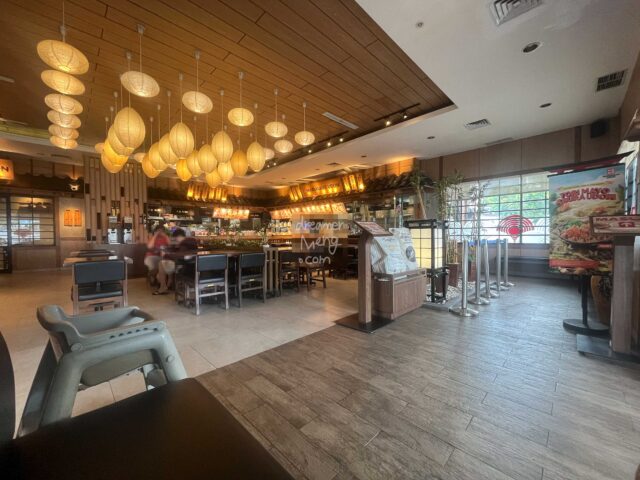
When I stepped into the restaurant, I was instantly surrounded by the unique Japanese vibe of Marugame Udon, which felt so different from what I had seen outside.
The first thing that grabbed my attention was the warm lighting hanging from the ceiling.

The first thing that grabbed my attention was the warm lighting hanging from the ceiling.
Those lights reminded me of traditional Japanese paper lanterns, casting a soft glow that created a cozy and inviting atmosphere. Additionally, the wooden panels on the ceiling added to the natural warmth of the space.
The dining area featured a clean and stylish design. The seating arrangement provided plenty of space, allowing customers to enjoy their meals comfortably. The overall color scheme, mixing warm wood tones with gentle lighting, contributed to a calm and relaxed vibe.

If I glanced toward the kitchen, I could see the open layout that let me watch the cooking process. This transparency made everything feel fresh and trustworthy. The Udon and Donburi (Japanese rice bowls) were prepared right after I ordered, turning the cooking into an interesting show.
Above the kitchen, a display board featured various menu items with illustrations, maintaining the traditional feel of a Japanese eatery. Thanks to the neatly organized menu and open kitchen, it was easy for me to pick my dishes while enjoying the excitement of watching the cooking happen.

Plus, the decorative wooden elements and wall art with traditional Japanese patterns really enhanced the atmosphere, making me feel like I was in a local restaurant in Japan.
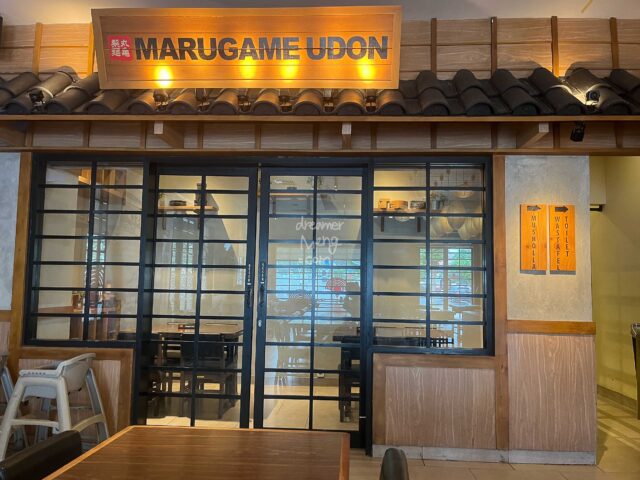
One thing that stood out was the designated Musholla (prayer room). It was quite rare to find eateries in Bali that included a Musholla, especially at an udon specialty spot. This thoughtful addition showed respect for local culture and highlighted Marugame Udon’s commitment to being in harmony with the community.

There are kids high chairs available for young customers.
Marugame Udon’s main menu features Udon and Donburi.
First, I checked the menu displayed above the ordering counter.
For Signature Udon, there are Kake Udon and Kamage Udon.
Other Udon options include Tori Baitan Udon, Abura Udon, Niku Udon, Curry Udon, Zaru Udon, and Carbonara Udon.
The Donburi menu includes Tendon Rice, Curry Rice, Teriyaki Chicken Rice, and Tori Rice. Additionally, there are Set and Bento options, as well as a Kids menu available.
I noticed the weekday promotions as well.

The “Oishii Lunch” deal runs from 10 AM to 5 PM on weekdays, and you can enjoy either Spicy Oden Udon or Kanikama Ankake Udon for just 49,000 rupiah.
I chose Kake Udon as usual.
After setting my tray down, I walked up to the chef to place my order. As soon as I did, the cooking began.
The chef expertly boiled the noodles and quickly handed me my freshly prepared Kake Udon.
Once I received my bowl, I placed it on my tray and continued walking, where I could check out the various side dishes available.
▶ Swipe to see more
The side menu offered various types of tempura, and tongs placed nearby allowed customers to take as much as they needed into their bowls.
For dipping the tempura, there was a sweet soy sauce available at the self-service station.

Since it said “Pick,” I grabbed the Tartar Mayo Sauce.
(Later, I found out that there was a small charge for it on the bill.)
I knew I would struggle to digest the tempura after eating my udon.
But with all those tasty tempura options, how could I just pass it by?

After thinking it over, I decided not to be greedy and just added Gyoza.
I turned the corner and got closer to the checkout counter. All I had to do now was choose a drink and pay.
There were a few different drinks to pick from, but I opted for the refillable Ocha.
Let’s prepare the Membership app card before checking out. It was easy—You can just download it from the App Store and sign up.
Before, I could earn points just by keeping the receipt from delivery orders and using a QR code. But since some people misused this system, now I can only earn points by paying in-store.

So far this year, I’ve collected 78 points. Next time I come, I plan to reach 80 points and use them to get Kake Udon!
After I finished paying, I placed my tray at the table.

Now, all I needed to do was head over to the self-service station nearby to grab some utensils and scoop up green onions and sauce as I liked.
The Ocha I ordered was here too, and I could refill it as much as I wanted from the dispenser.

▶ Swipe to see more

The Kake Udon that I ordered was one of the signature dishes at Marugame Udon, and it really stood out for its simplicity and rich flavor. The clear broth and thick, chewy noodles caught my attention right away.
The broth was clean and packed with deep umami flavor. With a soy sauce base that wasn’t too strong, it perfectly complemented the noodles. The warm udon soup felt comforting, almost like a cozy hug.
The noodles had a nice bounce and were chewy, making each bite enjoyable. Their thickness soaked up the delicious broth, adding to the experience.
I added some green onions and chopped chili from the self-service station, which gave it an extra fresh kick. Overall, it was a simple yet satisfying meal—just perfect for a quick lunch!
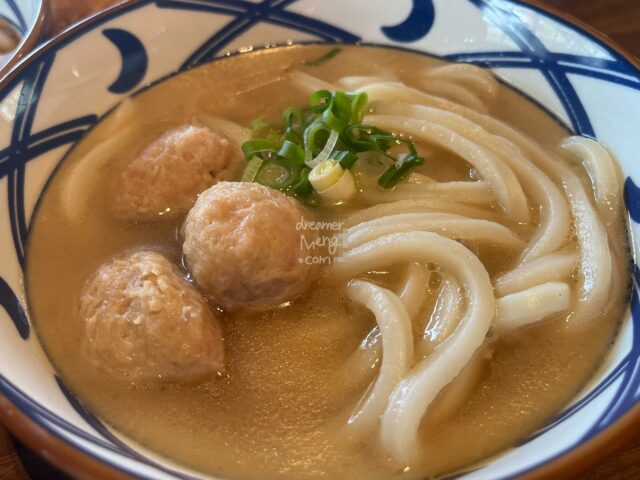
Here’s the Tori Baitan Udon that my friend ordered. The rich and tasty broth went really well with the chewy udon noodles, and the juicy chicken meatballs were a highlight.
My friend mentioned that the meatballs were soft and moist, which worked well with the broth, giving a nice balance of flavors. What stood out the most was how comforting and warming it was—definitely a great comfort food. My friend also said we picked a fantastic restaurant!

In the end, my Gyoza was packed up for me.
When I brought it to the counter in its dish, the staff kindly put it in a paper bag with some sauce.
Once I got home, I finally ate the Chicken Gyoza. It was still crispy and full of flavor, even though it had cooled down. The juicy chicken filling and the crunchy outside went really well together, so I could still enjoy its great taste, even after some time.
One of the great things about chain restaurants is that they offer consistent quality, no matter when or where you eat.
Since there’s usually little variation in taste from one location to another, first-time visitors can enjoy a satisfying meal without the risk of disappointment.






